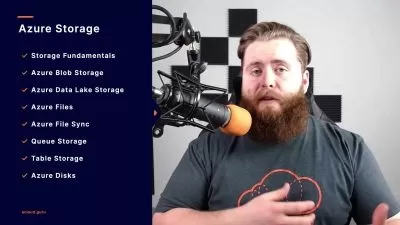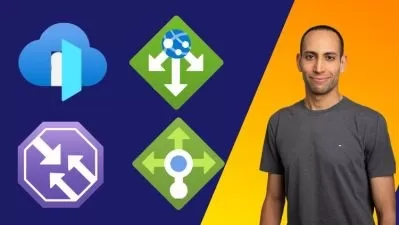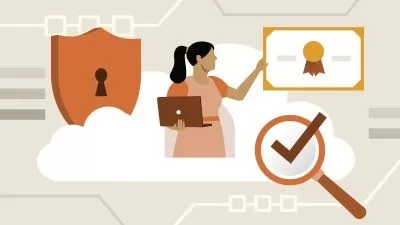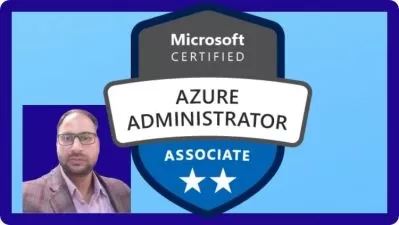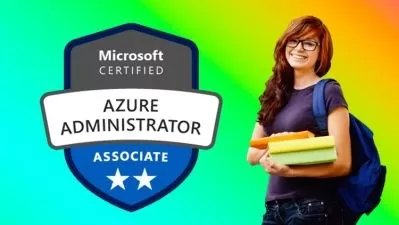AZ-104 Microsoft Azure Administrator course with SIMULATIONS
John Christopher
14:42:35
Description
Get prepared for the AZ-104 exam with instructor led labs and hands on simulations available 24/7
What You'll Learn?
- Learn the concepts and perform hands on activities needed to pass the AZ-104 exam
- Gain a tremendous amount of knowledge involving Microsoft Azure Services
- Get loads of hands on experience with Microsoft Azure Services
- Utilize hands on simulations that can be access anytime, anywhere!
Who is this for?
What You Need to Know?
More details
DescriptionWe really hope you'll agree, this training is way more than the average course on Udemy!
Have access to the following:
Training from an instructor of over 20 years who has trained thousands of people and also a Microsoft Certified Trainer
Lecture that explains the concepts in an easy to learn method for someone that is just starting out with this material
Instructor led hands on and simulations to practice that can be followed even if you have little to no experience
TOPICS COVEREDÂ INCLUDINGÂ HANDSÂ ONÂ LECTUREÂ ANDÂ PRACTICEÂ TUTORIALS:
Introduction
Welcome to the course
Understanding the Microsoft Environment
Having a Solid Foundation of Active Directory Domains
Having a Solid Foundation of RAS, DMZ, and Virtualization
Having a Solid Foundation of the Microsoft Cloud Services
Order of concepts covered in the course
Setting up for hands on
Using Assignments in the course
Creating a free Azure Account
Manage Azure Active Directory (Azure AD) objects
Creating users, guest accounts, and bulk updates
Activating Azure AD P2 license
Creating groups
Manage licenses in Azure AD
Create administrative units
Manage user and group properties
Manage device settings and device identity
Configure self-service password reset
Manage Azure using command line tools
Basic concepts of PowerShell
Installing PowerShell modules and Connecting to Azure
Interacting with Azure AD using PowerShell
Using Cloudshell
Using Azure CLI / Bash
Installing Azure CLI locally
Manage access control
Understanding the assignment of roles in Azure
Create custom role-based access control (RBAC) and Azure AD roles
Provide access to Azure resources by assigning roles at different scopes
Interpret access assignments
Manage Azure subscriptions and governance
Configure management groups
Manage subscriptions
Manage costs by using alerts, budgets, and recommendations
Manage resource groups
Apply and manage tags on resources
Configure and manage Azure Policy
Configure resource locks
Configure access to storage
Understanding storage accounts
Create and configure storage accounts
Configure network access to storage accounts
Configure Azure AD authentication for a storage account
Manage access keys
Generate shared access signature tokens
Configure stored access policies
Configure storage encryption
Manage data in Azure storage accounts
Create import and export jobs
Manage data by using Azure Storage Explorer and AzCopy
Understanding Azure Storage redundancy
Implement Azure Storage redundancy
Configure object replication
Configure Azure Files and Azure Blob Storage
Create an Azure file share and Configuring storage tiers
Configure Azure Blob Storage
Configure blob lifecycle management
Automate deployment of resources by using templates
Modify an ARM template
Deploy a template
Save a deployment as an ARM template
Deploy virtual machine (VM) extensions
Create and configure VMs
Create a VM
Create a VM using PowerShell
Manage images by using the Azure Compute Gallery
Configure Azure Disk Encryption
Move VMs from one resource group to another
Manage VM sizes
Add data disks
Configure VM network settings
Configure VM availability options
Deploy and configure VM scale sets
Create and configure containers
Understanding Azure Containers
Configure sizing and scaling for Azure Container Instances
Understanding container groups for Azure Container Instances
Configure storage for Azure Kubernetes Service (AKS)
Configure scaling for AKS
Configure network connections for AKS
Upgrade an AKS cluster
Create and configure an Azure App Service
Understanding App Service Plans
Create an App Service plan
Configure scaling settings in an App Service plan
Create an App Service
Secure an App Service
Configure custom domain names
Configure backup for an App Service
Configure networking settings
Configure deployment settings
Configure virtual networks
Visualizing virtual networks and subnets in Azure
Create and configure virtual networks and subnets
Creating virtual networks with PowerShell
Create and configure virtual network peering
Configure private and public IP addresses
Configure user-defined network routes
Configure Azure DNS
Configure secure access to virtual networks
Create and configure network security groups (NSGs) and ASGs
Evaluate effective security rules
Implement Azure Bastion
Visualizing service endpoints and private endpoints
Configure service endpoints and private endpoints
Configure load balancing
Visualizing Azure load balancing
Configure an internal or public load balancer
Configure Azure Application Gateway
Troubleshoot load balancing
Monitor virtual networking
Configure and use Azure Monitor for networks and on-premise connectivity
Use Azure Network Watcher
Troubleshoot external networking
Troubleshoot virtual network connectivity
Monitor resources by using Azure Monitor
Configure and interpret metrics
Configure Azure Monitor Logs
Query and analyze logs
Set up alerts and actions
Configure monitoring of VMs, storage accounts, and networks by using VM insights
Implement backup and recovery
Create an Azure Recovery Services vault
Create and configure backup policy
Perform backup and restore operations by using Azure Backup
Configure Azure Site Recovery for Azure resources
Configure and review backup reports
Finishing Up
Where do I go from here?
Who this course is for:
- IT people interested in learning and passing the Microsoft AZ-104 exam!
- IT people interested in learning a tremendous amount about Microsoft Azure Services!
We really hope you'll agree, this training is way more than the average course on Udemy!
Have access to the following:
Training from an instructor of over 20 years who has trained thousands of people and also a Microsoft Certified Trainer
Lecture that explains the concepts in an easy to learn method for someone that is just starting out with this material
Instructor led hands on and simulations to practice that can be followed even if you have little to no experience
TOPICS COVEREDÂ INCLUDINGÂ HANDSÂ ONÂ LECTUREÂ ANDÂ PRACTICEÂ TUTORIALS:
Introduction
Welcome to the course
Understanding the Microsoft Environment
Having a Solid Foundation of Active Directory Domains
Having a Solid Foundation of RAS, DMZ, and Virtualization
Having a Solid Foundation of the Microsoft Cloud Services
Order of concepts covered in the course
Setting up for hands on
Using Assignments in the course
Creating a free Azure Account
Manage Azure Active Directory (Azure AD) objects
Creating users, guest accounts, and bulk updates
Activating Azure AD P2 license
Creating groups
Manage licenses in Azure AD
Create administrative units
Manage user and group properties
Manage device settings and device identity
Configure self-service password reset
Manage Azure using command line tools
Basic concepts of PowerShell
Installing PowerShell modules and Connecting to Azure
Interacting with Azure AD using PowerShell
Using Cloudshell
Using Azure CLI / Bash
Installing Azure CLI locally
Manage access control
Understanding the assignment of roles in Azure
Create custom role-based access control (RBAC) and Azure AD roles
Provide access to Azure resources by assigning roles at different scopes
Interpret access assignments
Manage Azure subscriptions and governance
Configure management groups
Manage subscriptions
Manage costs by using alerts, budgets, and recommendations
Manage resource groups
Apply and manage tags on resources
Configure and manage Azure Policy
Configure resource locks
Configure access to storage
Understanding storage accounts
Create and configure storage accounts
Configure network access to storage accounts
Configure Azure AD authentication for a storage account
Manage access keys
Generate shared access signature tokens
Configure stored access policies
Configure storage encryption
Manage data in Azure storage accounts
Create import and export jobs
Manage data by using Azure Storage Explorer and AzCopy
Understanding Azure Storage redundancy
Implement Azure Storage redundancy
Configure object replication
Configure Azure Files and Azure Blob Storage
Create an Azure file share and Configuring storage tiers
Configure Azure Blob Storage
Configure blob lifecycle management
Automate deployment of resources by using templates
Modify an ARM template
Deploy a template
Save a deployment as an ARM template
Deploy virtual machine (VM) extensions
Create and configure VMs
Create a VM
Create a VM using PowerShell
Manage images by using the Azure Compute Gallery
Configure Azure Disk Encryption
Move VMs from one resource group to another
Manage VM sizes
Add data disks
Configure VM network settings
Configure VM availability options
Deploy and configure VM scale sets
Create and configure containers
Understanding Azure Containers
Configure sizing and scaling for Azure Container Instances
Understanding container groups for Azure Container Instances
Configure storage for Azure Kubernetes Service (AKS)
Configure scaling for AKS
Configure network connections for AKS
Upgrade an AKS cluster
Create and configure an Azure App Service
Understanding App Service Plans
Create an App Service plan
Configure scaling settings in an App Service plan
Create an App Service
Secure an App Service
Configure custom domain names
Configure backup for an App Service
Configure networking settings
Configure deployment settings
Configure virtual networks
Visualizing virtual networks and subnets in Azure
Create and configure virtual networks and subnets
Creating virtual networks with PowerShell
Create and configure virtual network peering
Configure private and public IP addresses
Configure user-defined network routes
Configure Azure DNS
Configure secure access to virtual networks
Create and configure network security groups (NSGs) and ASGs
Evaluate effective security rules
Implement Azure Bastion
Visualizing service endpoints and private endpoints
Configure service endpoints and private endpoints
Configure load balancing
Visualizing Azure load balancing
Configure an internal or public load balancer
Configure Azure Application Gateway
Troubleshoot load balancing
Monitor virtual networking
Configure and use Azure Monitor for networks and on-premise connectivity
Use Azure Network Watcher
Troubleshoot external networking
Troubleshoot virtual network connectivity
Monitor resources by using Azure Monitor
Configure and interpret metrics
Configure Azure Monitor Logs
Query and analyze logs
Set up alerts and actions
Configure monitoring of VMs, storage accounts, and networks by using VM insights
Implement backup and recovery
Create an Azure Recovery Services vault
Create and configure backup policy
Perform backup and restore operations by using Azure Backup
Configure Azure Site Recovery for Azure resources
Configure and review backup reports
Finishing Up
Where do I go from here?
Who this course is for:
- IT people interested in learning and passing the Microsoft AZ-104 exam!
- IT people interested in learning a tremendous amount about Microsoft Azure Services!
User Reviews
Rating
John Christopher
Instructor's Courses
Udemy
View courses Udemy- language english
- Training sessions 110
- duration 14:42:35
- Release Date 2022/11/30






